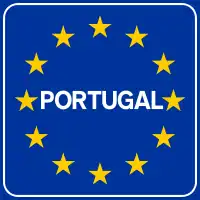Portugal–Spain border
The Portugal–Spain border is referred to as "The Stripe" (Galician: A Raia, Portuguese: A Raia, Mirandese: La Raia, Spanish: La Raya). It is one of the oldest borders in the world. The current demarcation is almost identical to that defined in 1297 by the Treaty of Alcañices. The Portugal–Spain border is 1,214 km (754 mi) long, and considered the longest uninterrupted border within the European Union. The border is not defined for 18 km (11 mi) between the Caia river and Ribeira de Cuncos, because of the disputed status of Olivenza/Olivença, which has been disputed between the two countries for two hundred years.
| Portugal–Spain border | |
|---|---|
 Guadiana International Bridge, connecting Portugal and Spain | |
| Characteristics | |
| Entities | |
| Length | 1214 km (Claimed by Portugal) / 1232 km (Claimed by Spain) |
| History | |
| Established | 1143 The victory of king Afonso I of Portugal over his cousin king Alfonso VII of León at the Battle of Valdevez, forced the Kingdom of León to recognise Portugal as a country, thus establishing the northern borders of Portugal. |
| Treaties | |
A microstate existed previously on the border called Couto Misto.
Bordering districts and provinces


Districts on the Portuguese side of the border from North to South:
 Viana do Castelo District (Northern Portugal)
Viana do Castelo District (Northern Portugal) Braga District (Northern Portugal)
Braga District (Northern Portugal) Vila Real District (Northern Portugal)
Vila Real District (Northern Portugal) Bragança District (Northern Portugal)
Bragança District (Northern Portugal) Guarda District (Central Portugal)
Guarda District (Central Portugal) Castelo Branco District (Central Portugal)
Castelo Branco District (Central Portugal) Portalegre District (Alentejo)
Portalegre District (Alentejo).png.webp) Évora District (Alentejo)
Évora District (Alentejo) Beja District (Alentejo)
Beja District (Alentejo) Faro District (Algarve)
Faro District (Algarve)
Provinces on the Spanish side of the border from North to South:
Customs and identity checks
Portugal and Spain signed the Schengen Agreement in June 1991 which came into effect on 26 March 1995, making Portugal and Spain part of the Schengen area and thus the border then became an Open border.[1]
Portugal has since reintroduced border checks several times along the border with Spain, during the UEFA Euro 2004 championships, during the NATO 2010 Lisbon summit and during Pope Francis's visit to Fátima in May 2017.[2]
On 16 March 2020 Portugal and Spain reintroduced border checks due to the COVID-19 pandemic, with tourists unable to cross, but allowing cross border workers and goods to pass.[3] The checks were planned until 15 May 2020,[4] but had been initially extended until 15 June 2020,[5] but were extended further to 1 July 2020.[6]
On 29 January 2021 Portugal closed the border with Spain, only people with exceptional reasons are able to cross. The planned closure is expected to last for 14 days.[7]
Maritime borders
Portugal's maritime borders, also known as the Exclusive economic zone of Portugal is currently disputed by Spain in the Savage Islands area, between Madeira and the Canary Islands.
Important treaties
- Treaty of Zamora (1143) - The victory of king Afonso I of Portugal over his cousin king Alfonso VII of León at the Battle of Valdevez, forced the Kingdom of León to recognise Portugal as a country, thus establishing the northern borders of Portugal.
- Treaty of Badajoz (1267) - Signed by king Alfonso X of Castile and King Afonso III of Portugal, establishing the Guadiana as roughly the southern border.
- Treaty of Alcañices (1297) - Signed by King Denis of Portugal (grandson of king Alfonso X of Castile) and King Ferdinand IV of Castile, Olivença is ceded to Portugal.
- Treaty of Badajoz (1801) - Olivença is ceded to Spain.
- Congress of Vienna (1815) - Spain promises to return Olivença to Portugal, leaving this area of the border disputed ever since.
- Treaty of Lisbon (1864) - This abolished the Couto Misto microstate.
- Convention of Limits (1926) - Demarcating the border from the confluence of Ribeira de Cuncos with the Guadiana, just south of Olivença, to the estuary of the Guadiana River, on the far South.
Border crossings

The main crossing point between Portugal and Spain is Vilar Formoso - Fuentes de Oñoro. Other important crossings are Caminha and Bragança to Galicia, Portalegre and Elvas to Badajoz, and Castro Marim and Vila Real de Santo António to Ayamonte.
Bridges across the border include the Guadiana International Bridge and the Lower Guadiana International bridge.
The World's shortest international bridge connects the Portuguese village of Várzea Grande (Arronches municipality) with the Spanish village of El Marco (La Codosera municipality). It is a wooden bridge with only 3.2 meters long.[8]
A zipline across the border exists between Sanlucar de Guadiana in Spain and Alcoutim in Portugal; it is the first and currently only zip line over an international border.[9][10]
References
- "The Schengen area - PDF by EU" (PDF). Retrieved 28 April 2017.
- "Portugal declares Papal holiday". Retrieved 28 April 2017.
- "Coronavirus: What you need to know about Spain closing its borders". Retrieved 18 March 2020.
- "Border with Spain to remain closed". Retrieved 18 April 2020.
- "Land borders with Spain to remain closed until June 15". Retrieved 15 May 2020.
- "Spain to open borders to EU, but Portugal remains off limits". Retrieved 15 June 2020.
- "Portugal closes land border with Spain as virus cases soar". Retrieved 31 January 2021.
- "The World's Shortest International Bridge". Retrieved 2019-11-26.
- "Spain becomes home to world's first-ever 'time-travelling' zipline". Retrieved 2020-03-29.
- "Travel From Spain To Portugal In Less Than A Minute With This Zany Zip-Line". Retrieved 2020-03-29.